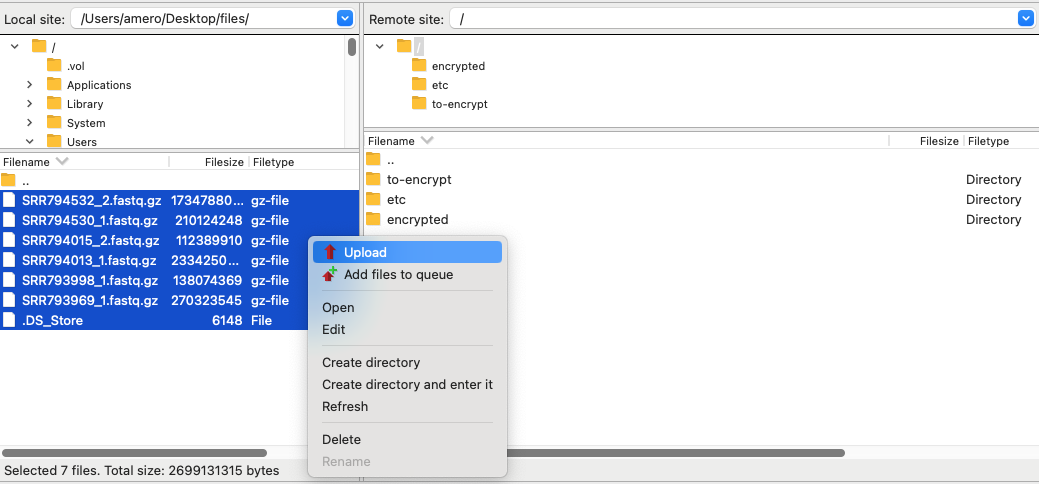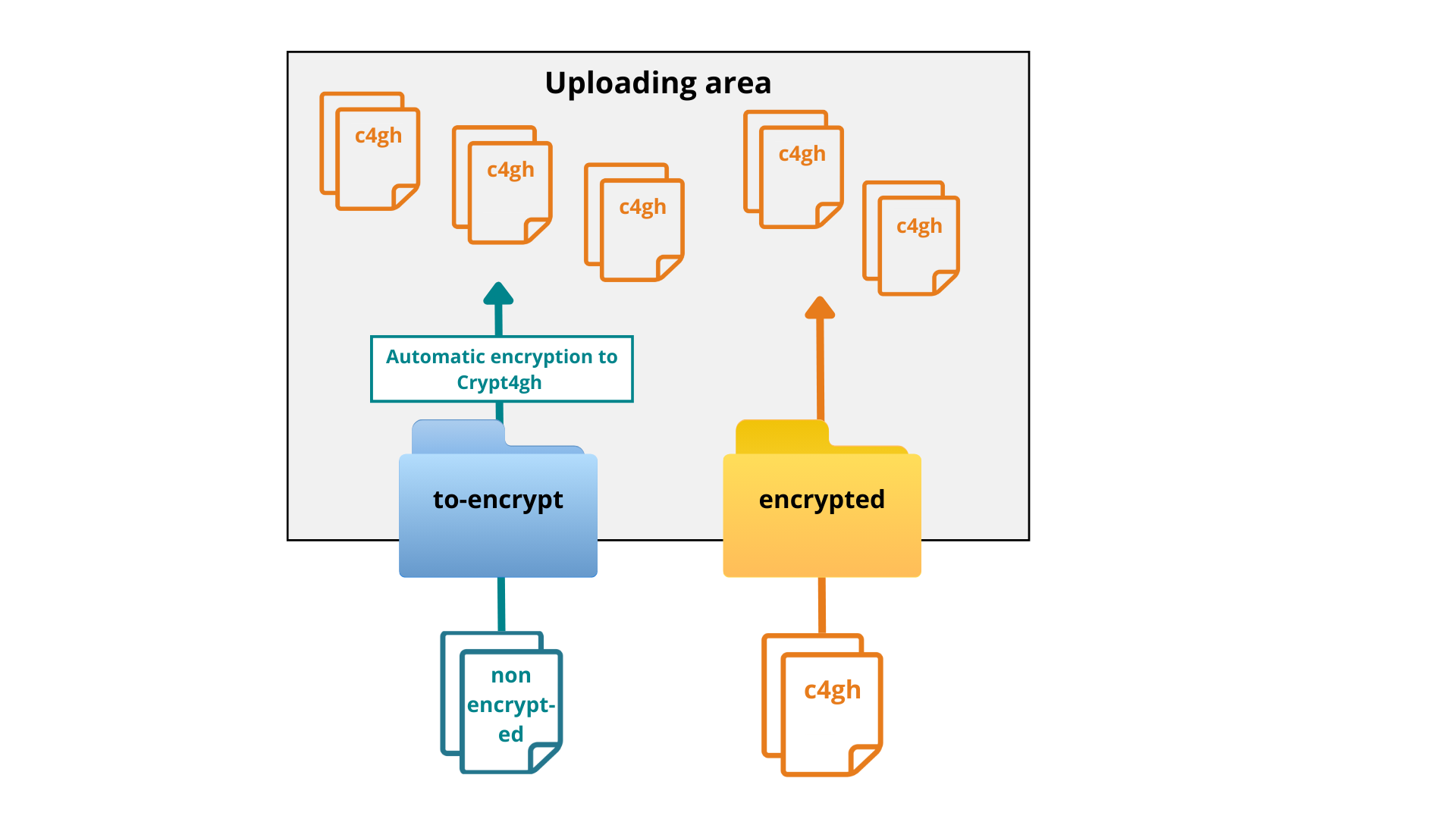Uploading files
Users that holds an ega-box-XXX account can upload files using either INBOX or FTP. Users who have a Submitter role associated with their email will only be able to upload files using INBOX.
Before uploading your files please make sure that any files that will be uploaded to EGA do not use special characters in their naming convention such as # ? ( ) [ ] / \ = + < > : ; " ' , * ^ | &. This can cause issues with the archiving process, leading to problems for end users.
The EGA is a shared, public service with limited storage. In order to manage the available resources, we enforce a limit of 10Tb per submission account at any one time. Please do not exceed this limit.
The INBOX is only compatible with files encrypted using the Crypt4gh tool
Before uploading
If you are not a registered EGA user, you will first need an EGA user account.
Please note that it may take a few days for your account to be activated, as it needs to be vouched for by the EGA Helpdesk. Once your account is validated you will be able to request a submitter role.
[Optional] Meanwhile, you can create and add your public key to your EGA account profile. This option is not available for old submission accounts (e.g. ega-box-NNN).
As soon as you have been granted a submitter role, you will be able to connect with your username and password to the EGA inbox using the SFTP protocol. If you have also registered a public key in your profile, you can also connect using this key.
To upload files to your account, you can use the graphical user interface (GUI) or the command line.
Graphical User Interface (GUI)
We recommend the use of FileZilla, a free, open source FTP client. However, you can use any other GUI that allows connecting over SFTP protocol.
For Filezilla as your GUI, follow these steps to upload files:
-
Create a new connection in Site Manager (File > Site Manager) and select the
following options (Figure 1):
- Protocol:
SFTP - SSH File Transfer Protocol - Host:
inbox.ega-archive.org - Logon Type:
Key file - User: your
EGA username - Key file:
Path/to/your/private_key
- Protocol:
- Click Connect and you will login remotely to your inbox home directory. You can think of this folder as a storage "in the EGA cloud" in which you will add your files for the EGA. The uploading area have three folders:
- To-encrypt: Files uploaded in this folder will encrypt automatically on the fly.
- Encrypted: Files uploaded in this folder must be already encrypted with Crypt4gh. Upload your files here if your connection is unstable or you have problems completing the upload in to-encrypt.
- Etc: This folder contains two files that allow the server to show you your username and group instead of some internal numbers. Please do not upload files here, otherwise you will obtain a permission denied error.
- Find the files you want to upload by browsing your local storage (left side of your screen in FileZilla). Select all the files you want to upload, then right click on them and select Upload (Figure 2).

Figure 1: Process of establishing a new connection to inbox.ega-archive.org using a key file as the logon method in FileZilla. The figure showcases the FileZilla version 3.52.2 operating on IOS v11.2.3. By following the depicted steps, users can create a secure and efficient connection to the inbox, ensuring seamless data transfers.

Figure 2: Step-by-step process of manually uploading files to inbox.ega-archive.org using FileZilla, with FileZilla version 3.52.2 operating on IOS v11.2.3. The figure demonstrates how users can transfer data from their local storage to the "EGA cloud" by following the depicted steps
Please note that regardless of which folder you upload your files in, both folders (to-encrypt, encrypted) will point to the same path (/) (Figure 3). Therefore, you will see your files in both folders.

Figure 3: Both folders, to-encrypt and encrypted, point to the same path (/)"
If your connection is unstable, please encrypt your files first using Crypt4gh. Then upload them to the ‘encrypted’ folder.
The example above shows how to connect to inbox.ega-archive.org using the private key. However, if you prefer to login using your credentials, you can do so. Please go the Frequently Asked Questions (FAQs) for more information.
SFTP command line
To upload files securely to your private area of the EGA, you can use SFTP(Secure File Transfer Protocol) with your favourite FTP client. Here's what you need to know to get started:
- Connect to the target host inbox.ega-archive.org. This is the new hostname for the EGA SFTP service.
- Login with your EGA username and key files (or password).
- Upload files to your private EGA inbox to ensure that only you can access the files.
By following these steps, you can securely upload your files to the EGA for safe storage and sharing.
Using SFTP command line client in Linux/Unix
- Open a terminal and type
sftp username@hostname - Enter your EGA password
- To see a list of available sftp commands type
help - sftp>
put– Upload file - sftp>
get– Download file - sftp>
cd path– Change remote directory to ‘path’ - sftp>
pwd– Display remote working directory - sftp>
lcd path– Change the local directory to ‘path’ - sftp>
lpwd– Display local working directory - sftp>
ls– Display the contents of the remote working directory - sftp>
lls– Display the contents of the local working directory - Type put command to upload files. For example:
put *.bam - Use the
byecommand to close the connection (SFTP session).
After uploading
Once all the metadata has been created for an ongoing submission and the files have been ingested, please delete the files from your SFTP INBOX before finalising your submission. This will prevent the files from reappearing in your Submitter Portal Inbox.
Frequently Asked Questions
Specific to inbox
What username should I use to log in to my inbox?
The authentication process for logging in to the EGA website, as well as accessing your inbox and outbox, requires the use of your username, not your email address. Therefore, if you registered a username different from your email address when creating your EGA account, you must use that username to log in.
If you have forgotten your registered username, please, contact our Helpdesk team for assistance.
How are checksums calculated in your inbox?
If you encrypt the file beforehand and upload it to the "encrypted" folder, the unencrypted checksum will not be calculated until the file is ingested (i.e., until it is used in a run/analysis). If the file is uploaded to the "to-encrypt" folder, then both checksums are calculated.
Specific to using keys to authenticate
Can I access one EGA account from different devices?
Yes, you can access your account from different devices by linking several public keys to your EGA account. Each device can generate a unique public-private key pair, and the corresponding public keys can be linked to the same account. This way, you can use different public keys on different devices and still have access to the same account and data.
I have several keys and I don't remember which one is which
When generating SSH keys, it's a good practice to add a comment using the -C flag. This will allow you to add a descriptive tag to your key, making it easier to identify later on. Here's an example command that generates an SSH key with a comment:
ssh-keygen -t ed25519 -C work-pass
In this example, we're generating an ed25519 SSH key with the comment work-pass. Once you have multiple keys with different comments, you can use
the comments to easily identify each key.
To view the comments for your existing SSH keys, you can use the following command:
ssh-keygen -l -f /path/to/key
This will display the key fingerprint and the associated comment. By checking the comments, you should be able to identify which key is which.
What if I can't find my SSH keys for uploading files with a key file, and how can I use new keys?
If you can't find your SSH keys, don't worry - you can make new ones. To do this, open your terminal or command prompt and type a command to make a new SSH key. You can pick a name for the key, and choose a password to keep it safe. After making the key, you can add the new key to your account or server where you want to upload files using the key file. This usually involves copying and pasting the key's "public" (e.g. file.pub) part to the right place. If you lose track of the key again, just make a new one and add it again.
Keep in mind that SSH keys belong to you and your computer, so if you switch computers or accounts, you'll need to make new keys.
I don't want to type the passphrase every time I use the key. What can I do?
You can use an ssh-agent to avoid typing the passphrase every time you use the key. An ssh-agent is a program that stores your private keys in memory and provides them to ssh when needed. You can add your key to the ssh-agent using the command ssh-add followed by the path to your key file.Here's an example of the steps to follow:
- Open a terminal window.
- Start the ssh-agent by typing the command
eval $(ssh-agent). - Add your key to the ssh-agent by typing the command
ssh-add [key filepath].
For instance, if your key file is located in the home directory with the name mykey, the command will look like this:
ssh-add ~/mykey
After adding your, key to the ssh-agent, you should be able to use ssh without having to enter your passphrase every time.
Can I use my password for authentication (without my private key)?
If you prefer to use your username and password for authentication instead of your private key, you can still do so. When using a Graphical User Interface (GUI) such as FileZilla, you can select Ask for password as your Logon Type (Figure 3). This option will prompt you to enter your password when you click
Connect, instead of using your private key.

Figure 3: This option will prompt you to enter your password when you click "Connect", instead of using your private key. Figure 3: Process of establishing a new connection to inbox.ega-archive.org using your password as the logon method in FileZilla. The figure showcases the FileZilla version 3.52.2 operating on IOS v11.2.3. By following the depicted steps, users can create a secure and efficient connection to the inbox, ensuring seamless data transfers.
It's worth noting that using a password for authentication can be less secure than using an SSH key, as passwords can be more easily compromised through various means. However, if you choose to use your password for authentication, selecting "Ask for password" as your Logon Type is a good way to do so securely via a GUI.
Why is it better to use my key and not my password?
SSH keys for authentication is generally considered to be more secure and convenient than using passwords. SSH keys are more difficult to crack than passwords, and they can be restricted to specific users and machines, giving you more control over access. Once you set up your SSH keys, you can use them to authenticate quickly and easily, without having to enter a password every time. This makes automation of tasks, such as uploading encrypted files, much simpler. Additionally, SSH keys provide better logging, allowing you to keep track of who is accessing your systems and when. All in all, using SSH keys is a good practice for improving security and convenience in your authentication process.
